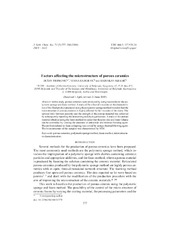Factors affecting the microstructure of porous ceramics
Faktori koji utiču na mikrostrukturu porozne keramike
Апстракт
In this study, porous ceramics were produced by using two methods: the polymeric sponge and foam method. A study of the effect of viscosity on the characteristics of the final product produced using the polymeric sponge method revealed that the microstructure of porous ceramics is highly affected by the viscosity of the slurry. The optimal ratio between porosity and the strength of the porous material was achieved by subsequently repeating the immersing and drying processes. A study of the porous material obtained using the foam method revealed that the pore size and foam volume can be controlled by varying the amounts of anhydride and thermal blowing agent. The problem related to foam collapsing was solved by using a thermal blowing agent. The microstructure of the samples was characterized by SEM.
U ovom radu je porozna keramika dobijena na dva načina: metodom polimernog sunđera i metodom pene. Pokazano je da mikrostruktura finalnog proizvoda zavisi od načina izvođenja procesa i uzajamnog odnosa komponenata u keramičkoj smeši. Optimalni odnos između poroznosti i jačine keramičkog materijala dobijenog metodom polimernog sunđera je postignut variranjem viskoznosti smeše i ponavljanjem stupnjeva potapanja i sušenja sunđera. Stabilnost pene u procesu dobijanja porozne keramike metodom pene je postignuta variranjem supstanci koje uzrokuju stvaranje pene. Mikrostruktura uzoraka je okarakterisana SEM-om.
Кључне речи:
porous ceramics / polymeric sponge method / foam method / microstructure characterizationИзвор:
Journal of the Serbian Chemical Society, 2006, 71, 3, 277-284Издавач:
- Serbian Chemical Society, Belgrade
Институција/група
Tehnološko-metalurški fakultetTY - JOUR AU - Tripković, Dušan AU - Radojević, Vesna AU - Aleksić, Radoslav PY - 2006 UR - http://TechnoRep.tmf.bg.ac.rs/handle/123456789/1000 AB - In this study, porous ceramics were produced by using two methods: the polymeric sponge and foam method. A study of the effect of viscosity on the characteristics of the final product produced using the polymeric sponge method revealed that the microstructure of porous ceramics is highly affected by the viscosity of the slurry. The optimal ratio between porosity and the strength of the porous material was achieved by subsequently repeating the immersing and drying processes. A study of the porous material obtained using the foam method revealed that the pore size and foam volume can be controlled by varying the amounts of anhydride and thermal blowing agent. The problem related to foam collapsing was solved by using a thermal blowing agent. The microstructure of the samples was characterized by SEM. AB - U ovom radu je porozna keramika dobijena na dva načina: metodom polimernog sunđera i metodom pene. Pokazano je da mikrostruktura finalnog proizvoda zavisi od načina izvođenja procesa i uzajamnog odnosa komponenata u keramičkoj smeši. Optimalni odnos između poroznosti i jačine keramičkog materijala dobijenog metodom polimernog sunđera je postignut variranjem viskoznosti smeše i ponavljanjem stupnjeva potapanja i sušenja sunđera. Stabilnost pene u procesu dobijanja porozne keramike metodom pene je postignuta variranjem supstanci koje uzrokuju stvaranje pene. Mikrostruktura uzoraka je okarakterisana SEM-om. PB - Serbian Chemical Society, Belgrade T2 - Journal of the Serbian Chemical Society T1 - Factors affecting the microstructure of porous ceramics T1 - Faktori koji utiču na mikrostrukturu porozne keramike EP - 284 IS - 3 SP - 277 VL - 71 UR - https://hdl.handle.net/21.15107/rcub_technorep_1000 ER -
@article{
author = "Tripković, Dušan and Radojević, Vesna and Aleksić, Radoslav",
year = "2006",
abstract = "In this study, porous ceramics were produced by using two methods: the polymeric sponge and foam method. A study of the effect of viscosity on the characteristics of the final product produced using the polymeric sponge method revealed that the microstructure of porous ceramics is highly affected by the viscosity of the slurry. The optimal ratio between porosity and the strength of the porous material was achieved by subsequently repeating the immersing and drying processes. A study of the porous material obtained using the foam method revealed that the pore size and foam volume can be controlled by varying the amounts of anhydride and thermal blowing agent. The problem related to foam collapsing was solved by using a thermal blowing agent. The microstructure of the samples was characterized by SEM., U ovom radu je porozna keramika dobijena na dva načina: metodom polimernog sunđera i metodom pene. Pokazano je da mikrostruktura finalnog proizvoda zavisi od načina izvođenja procesa i uzajamnog odnosa komponenata u keramičkoj smeši. Optimalni odnos između poroznosti i jačine keramičkog materijala dobijenog metodom polimernog sunđera je postignut variranjem viskoznosti smeše i ponavljanjem stupnjeva potapanja i sušenja sunđera. Stabilnost pene u procesu dobijanja porozne keramike metodom pene je postignuta variranjem supstanci koje uzrokuju stvaranje pene. Mikrostruktura uzoraka je okarakterisana SEM-om.",
publisher = "Serbian Chemical Society, Belgrade",
journal = "Journal of the Serbian Chemical Society",
title = "Factors affecting the microstructure of porous ceramics, Faktori koji utiču na mikrostrukturu porozne keramike",
pages = "284-277",
number = "3",
volume = "71",
url = "https://hdl.handle.net/21.15107/rcub_technorep_1000"
}
Tripković, D., Radojević, V.,& Aleksić, R.. (2006). Factors affecting the microstructure of porous ceramics. in Journal of the Serbian Chemical Society Serbian Chemical Society, Belgrade., 71(3), 277-284. https://hdl.handle.net/21.15107/rcub_technorep_1000
Tripković D, Radojević V, Aleksić R. Factors affecting the microstructure of porous ceramics. in Journal of the Serbian Chemical Society. 2006;71(3):277-284. https://hdl.handle.net/21.15107/rcub_technorep_1000 .
Tripković, Dušan, Radojević, Vesna, Aleksić, Radoslav, "Factors affecting the microstructure of porous ceramics" in Journal of the Serbian Chemical Society, 71, no. 3 (2006):277-284, https://hdl.handle.net/21.15107/rcub_technorep_1000 .



